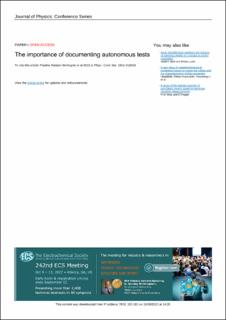| dc.contributor.author | Bellingmo, Pauline Røstum | |
| dc.contributor.author | Fjørtoft, Kay Endre | |
| dc.contributor.author | Jørgensen, Ulrik | |
| dc.contributor.author | Kvam, Per Erik | |
| dc.contributor.author | Bratbergsengen, Inger Lill | |
| dc.contributor.author | Gisbert, Jose Vicente Perello | |
| dc.date.accessioned | 2022-08-11T12:29:27Z | |
| dc.date.available | 2022-08-11T12:29:27Z | |
| dc.date.created | 2022-08-08T11:50:03Z | |
| dc.date.issued | 2022 | |
| dc.identifier.citation | Journal of Physics: Conference Series (JPCS). 2022, 2311 1-12. | |
| dc.identifier.issn | 1742-6588 | |
| dc.identifier.uri | https://hdl.handle.net/11250/3011297 | |
| dc.description.abstract | This paper presents how autonomous tests can be documented and why this is important. A test area in Norway, more specifically the Trondheimsfjorden Test Area for Autonomous Ships, is used as a pilot to conduct tests with autonomous vessels and for demonstrating the procedure of documenting results. There are typically three stages in such a documentation process; 1) To register and inform about a planned test on the fjord, 2) To inform about ongoing tests and to document test results by collecting data from the vessel and from the sensor infrastructure, 3) To show historical tests and be able to do analytics or conduct learning from previous tests. The Trondheimsfjorden Test Area has been instrumented with communication and navigation infrastructure, a control centre for control and monitor of the install infrastructure and for remote operation of a ship, and a data centre for planning autonomous tests, storing data, and for sharing of test results. By documenting test results in a standardized format, this can be used to verify new technology and solutions, share knowledge and experiences, and for documentation procedures and guidelines used for the purpose. A demonstration held in The Trondheimsfjorden Test Area showed the importance of streamlining the process of conducting autonomous test and documenting them in a standardized format. This work is based on the results from the research project NAVISP-EL3-005 "Trondheimsfjorden Test Area for Autonomous Ships". The Navigation Innovation and Support Programme (NAVISP) is the programme of the European Space Agency to support the competitiveness of the European industry in the wide field of positioning, navigation and timing while supporting member states in enhancing national objectives and capabilities in the sector. | |
| dc.language.iso | eng | |
| dc.title | The Importance of Documenting Autonomous Tests | |
| dc.title.alternative | The Importance of Documenting Autonomous Tests | |
| dc.type | Peer reviewed | |
| dc.type | Journal article | |
| dc.description.version | publishedVersion | |
| dc.source.pagenumber | 1-12 | |
| dc.source.volume | 2311 | |
| dc.source.journal | Journal of Physics: Conference Series (JPCS) | |
| dc.identifier.doi | 10.1088/1742-6596/2311/1/012019 | |
| dc.identifier.cristin | 2041683 | |
| dc.relation.project | Norges forskningsråd: 295647 | |
| dc.relation.project | ESA - den europeiske romfartsorganisasjonen: 4000126490/19/NL/MP- NAVISP-EL3 | |
| cristin.ispublished | true | |
| cristin.fulltext | original | |
| cristin.qualitycode | 1 | |
